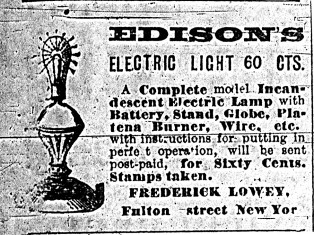 Early settlers had more than one way to light up their log cabins. Candles, kerosene, and lard-oil lamps were among the few. These types of lights were a fire hazard and in many cases were responsible for entire towns being burnt down. A safer way to provide light to homes was being sought in England. Sir Humphrey Davy was working on producing electric arcs using a platinum wire incandescent and passing a current through the air. By 1840 a number of incandescent lamps, including Davy’s, were being patented, but none were commercially successful until American inventor Thomas Alva Edison produced his carbon filament lamp in 1879. Edison’s electric light was a much sought after product. It worked by passing a weak electric current between a heated filament and a cold electrode. The first power station was constructed on Pearl Street in New York. In 1882 several miles of streets were dug up to install electric cables from the station to surrounding homes, which began receiving electric current on September 4. Electric lighting didn’t dominate the Old West until the end of the century.
Early settlers had more than one way to light up their log cabins. Candles, kerosene, and lard-oil lamps were among the few. These types of lights were a fire hazard and in many cases were responsible for entire towns being burnt down. A safer way to provide light to homes was being sought in England. Sir Humphrey Davy was working on producing electric arcs using a platinum wire incandescent and passing a current through the air. By 1840 a number of incandescent lamps, including Davy’s, were being patented, but none were commercially successful until American inventor Thomas Alva Edison produced his carbon filament lamp in 1879. Edison’s electric light was a much sought after product. It worked by passing a weak electric current between a heated filament and a cold electrode. The first power station was constructed on Pearl Street in New York. In 1882 several miles of streets were dug up to install electric cables from the station to surrounding homes, which began receiving electric current on September 4. Electric lighting didn’t dominate the Old West until the end of the century.
Follow Me
© 2025 Chris Enss | Privacy Policy | Design by Winter Street Design Group | Login




